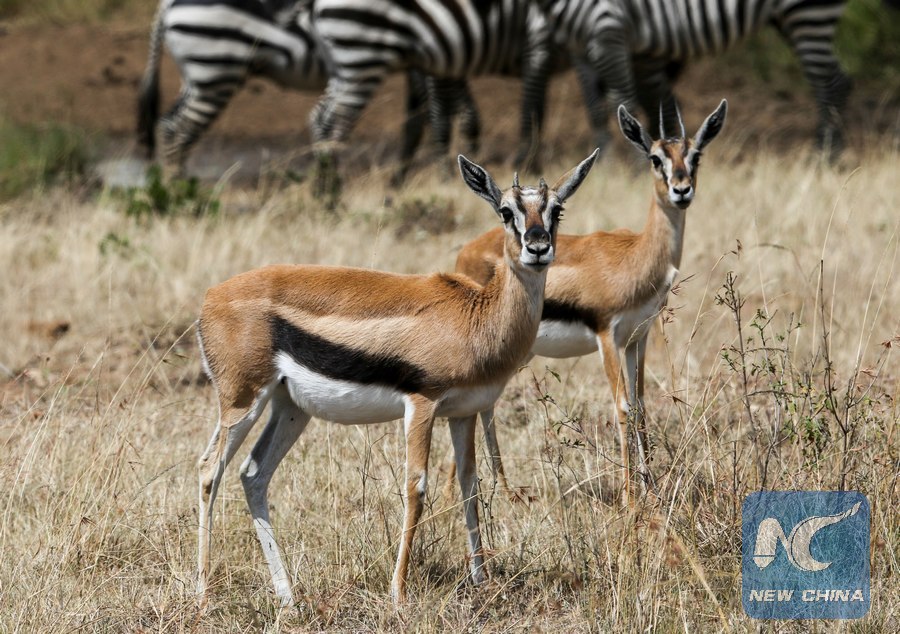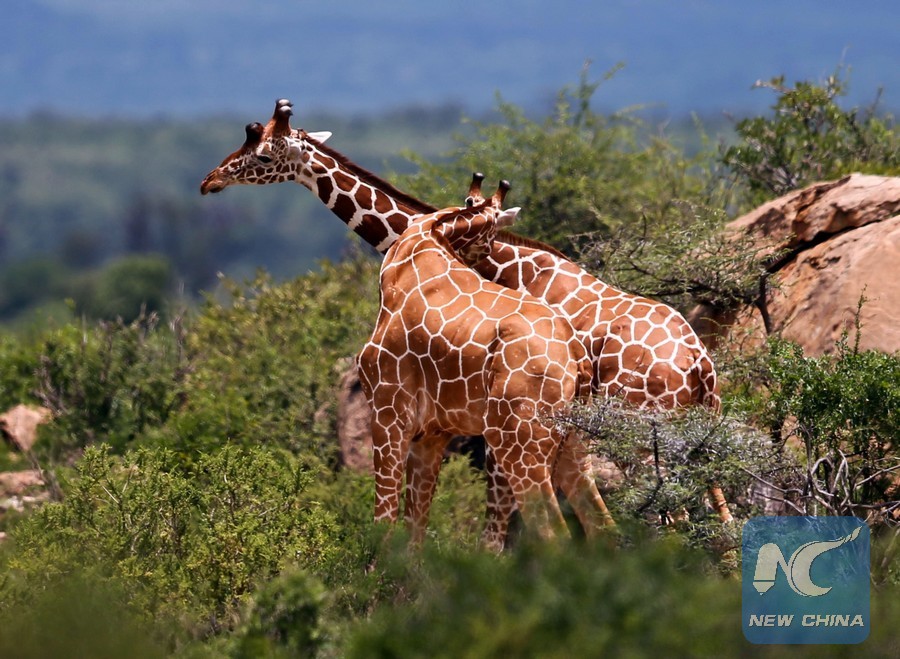
A couple of gazelles are seen at the Maasai Mara National Reserve, Kenya, July 23, 2016. The Maasai Mara National Reserve, popularly known as Africa's Greatest Wildlife Reserve, is a great tourist attraction center as it offers visitors an opportunity to observe the Africa's "big five": lion, cheetah, elephant, buffalo and rhino. (Xinhua/Pan Siwei)
NAIROBI, Aug. 2 (Xinhua) -- Scientists have called for an urgent action to help save Kenya's wildlife population from the current massive decline.
The Kenyan and German scientists who conducted an aerial survey of wildlife in the East Africa nation said wildlife population has declined by around 68 percent from 1977-2018.
"Increased human and livestock populations and climate change are to blame for the decline," Joseph Ogutu, lead researcher and lecturer at German's University of Hohenheim, Germany said in a recent study.
The survey found out that seven wildlife species across Kenya were classed as critically endangered, 19 as endangered and 37 as vulnerable by 2013 while 44 ecosystems currently classed as endangered.
Ogutu said the decline shows no signs of stopping, with species like the Thomson's gazelle, warthog and oryx among others, now under severe threat while numbers of Grevy's zebra and waterbuck have fallen lower than 2,000, putting them amongst a number of species whose future viability is under extreme risk.

Photo taken on June 20, 2017 shows black rhinos in the Lake Nakuru National Park, Kenya. Lake Nakuru lies to the south of Nakuru, in the rift valley of Kenya and is protected by Lake Nakuru National Park. The lake's abundance of algae attracts a vast quantity of flamingos that famously lined the shore. Other birds also flourish in the area, as do warthogs, baboons and other large mammals. Eastern black rhinos and southern white rhinos have also been introduced. (Xinhua/Chen Cheng)
He said that although some species appear to do well when living in conjunction with humans, this has led to those which are particularly vulnerable to human expansion suffering some of the hardest losses.
The scientist said degradation and fragmentation of rangeland habitats, clearing for agriculture, settlements and uncontrolled logging for the charcoal trade may be preventing wildlife from utilizing certain areas.
The team also found that some migratory species, such as wildebeest and zebra are less likely to venture into the Mara region during dry seasons than previously seen, suggesting that these factors are contributing to a disruption of migration routes.
The study found that even though overgrazing is causing the degradation of forage resources hence the decline of cattle in the areas, sheep and goats have seen massive growth over the study period.
According to the survey, the populations of sheep, goats and camels increased by more than 76 percent, a likelihood that the increase is putting added grazing pressure on land that is shared with wildlife and restricting their access to resources and cover.
"Competition with livestock, aggravated by poor forage due to steadily climbing temperatures, has driven wild buffalo from some areas altogether," he added.
Ogutu suggested that more needs to be done to encourage wildlife conservancies across Africa, not just in Kenya.
"It is important governments make wildlife conservancies economically viable for poor landowners to volunteer their land for use by wildlife and prevent the poisoning and poaching of wild species, as a way of restoring wildlife populations and their ecosystems," Ogutu noted.

Two reticulated giraffes fight each other at Samburu National Reserve, north of Kenya, April 20, 2013. The Samburu National Reserve is located in northern Kenya with 165 square kilometers in size. It attracts animals because of the Ewaso Ng'iro river that runs through it and the mixture of acacia, riverine forest, thorn trees and grassland vegetation. Grevy's zebra, gerenuk, reticulated giraffes and beisa oryx here are more than those in other regions of the country. Besides, the reserve is also home to lion, crocodile. baboon, elephant and hundreds of species of birds. (Xinhua/Meng Chenguang)
He cited Nakuru Conservancy that has succeeded as many previously declining species showed a marked increase between 1996 and 2015.
The scientist praised Kenya for adapting the Wildlife Conservation and Management Act in 2013 but said that some restrictions need to be placed on land fragmentation such as through fences, illegal livestock grazing in parks, reserves and conservancies and livestock levels to reduce the impact of grazing on the rangelands.
He said some landowners use the money from conservancies to build fences and increase their livestock herd size, causing further competition between their livestock and wildlife benefiting from the conservancies.
The scientist observed that for the realization of conservation goals to be achieved, there is need for continued monitoring of population trends.
"Wildlife conservancies, paired with policy reviews, effective wildlife management institutions and vibrant markets for wildlife will be the best way forward for conservation in Kenya," he added.

